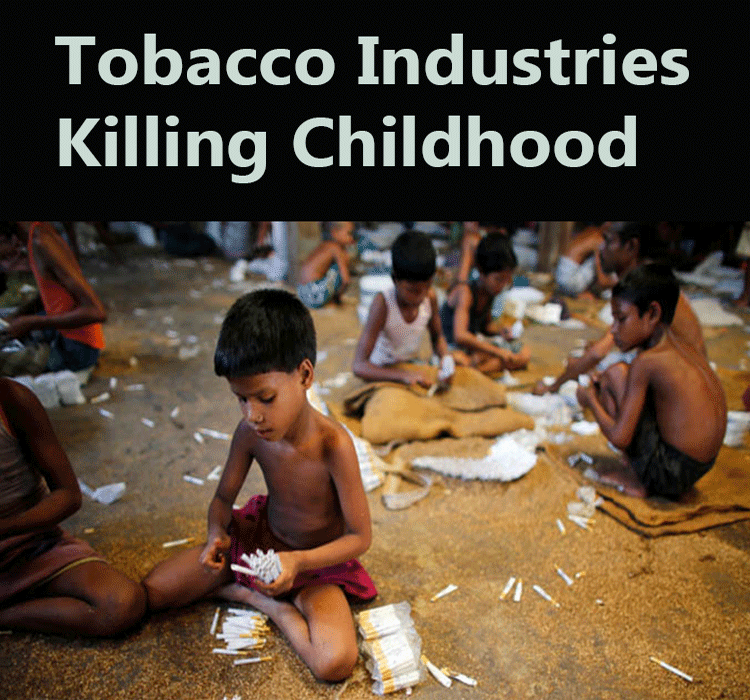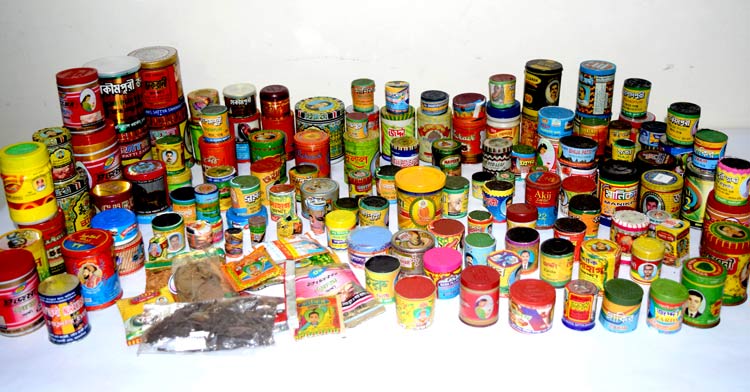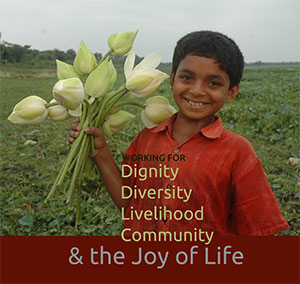
As a part of its regular market monitoring activities, Tabinaj – the Women’s Alliance against Tobacco conducted a survey on a particular SLT product, namely Zarda, from July 11 to 20, 2023 in three marketplaces of the Dhaka city–Mohammadpur Town Hall Market, Krishi Market, and Karwan Bazar. In these three marketplaces, Zarda is sold in shops that have names as zarda shop, while the others sell zarda along with other groceries. A total of 34 brands of Zarda products have been

Children fill up empty cigarettes manually in a small cigarette factory in Rangpur. Photo: Reuters
The tobacco industry continues its efforts to undermine public health efforts of the government so that they can get more and more users of the products. This must be stopped.
The ninth Conference of the Parties (COP9) of the WHO FCTC (World Health Organisation Framework Convention on Tobacco Control) started with the message that 'the tobacco epidemic has not gone away,' despite w

The current law is inadequate to control the social and economic complexities involved in the production and use of smokeless tobacco products
The offer of a paan (betel leaf) with zarda (boiled tobacco) after a heavy meal at a wedding party, or even at a relative's house, is very much appreciated and socially well accepted in our country.
We do not even get concerned when our elders, particularly mothers or grandmothers, chew paan with zarda or shada pata (dried tobacco leaf),

Investigation by UBINIG (Policy Research for Development Alternative)
Smokeless tobacco use in Bangladesh
In Bangladesh, 20.6% of adult population (22 million) uses smokeless tobacco. The mostly used smokeless tobacco (SLT) products are Zarda, Gul and Sadapata. Overall among the 37.8 million tobacco users in the country, smokeless tobacco use is higher (20.6%) than smoking 18% [1]. Bangladesh ranks the third

Smokeless tobacco (SLT) use in Bangladesh is high, yet it is generally held that SLT manufacturing often occurs outside the tax net. This study examines SLT production, pricing and turnover for a sample of 88 SLT manufacturers operating outside the tax net and identifies factors perceived to contribute to non-payment of taxes by SLT manufacturers.
SLT taxation is governed by the Value Added Tax and Supplementary Duty Act, 2012. The government introduced maximum retail price (MRP) as t

Investigation conducted by UBINIG (Policy Research for Development Alternative)
Smokeless Tobacco Use in Bangladesh
Smokeless tobacco (SLT) is an addictive and deadly tobacco product that causes cancers of the oral cavity, pancreas, and esophagus and, for pregnant women, increases the risk of still births and premature delivery.1,2 Bangladesh has one of the high

Grown in Bangladesh in north Bengal (along the Teesta river banks) and other districts: 19960 acres (17%) of total cultivation. 12177 mt. tons (14%) of total tobacco leaf production. 12177 mt. tons (14%) of total tobacco leaf production. (UBINIG Factsheet: 2 August 2020)
Motihari tobacco (Ni

UBINIG Factsheet 1 August 2020
Bangladesh has high consumption rate of smokeless or chewing tobacco. One in five (20.6%) of adult population (22 million) use smokeless tobacco such as Zarda, Gul, Khaini and Sadapata. Among adult women, tobacco use that is smokeless tobacco, is 24.8%, smoking rate is less than 1%. In contrast, use rate of smokeless tobacco among adult men is 16.2% while smoking is 36.2%. Overall among the 37.8 millio

Equality of women in paid work has been a long demand of the women’s movement and is one of the primary focuses in the Sustainable Development Goal 5. The SDG 5, among the 17 goals, is about empowering women and promoting gender equality. Ending all forms of discrimination against women and girls is a basic human right; and also a pre-condition for achieving overall sustainable development. Like other countries, in Bangladesh, patriarchal social, economic and cultural factors contribu

Betel quid or Paan-jarda use is a common practice among men and women in the rural and urban lower income groups. This is a socially accepted practice and unlike cigeratte or biri does not have any cultural barrier. Although it is an open practice, there is gap of information about the users, which becomes a constraint in developing any regulatory framework for reducing consumption under the provision of the existing tobacco control law as amended in 2013.

Tobacco product ingredients: UBINIG-Tabinaj, 2016
Ingredients in tobacco products are used to increase their attractiveness, addictiveness, and toxicity. Tobacco product ingredients are the substances, components, and raw materials that when put together make up a tobacco product ready to be used. The main ingredients of tobacco products are: the processed tobacco leaf and the substances intentionally added to increase the attracti

It is well-recognized fact through various public health research works, although insufficient, that smokeless tobacco consumption cause certain health hazards. Some smokeless tobacco products, such as Jarda and Sadapata are consumed with betel leaves, known as paan, along with lime and betel nut. This is an open and common practice among men and women. Another common smokeless tobacco is Gul, commonly used as an oral tobacco powder which is rubbed over the gum and teeth. Being a tobacco prep

Tobacco cultivation in Bangladesh has always been river-based to exploit the fertile soil. Tobacco, mostly Flue Cured Virginia (FCV) and Barley variety, is a company sponsored crop grown since the last five decades. According to official data for 2016, tobacco is grown on 46,472 hectares of land, producing 87,628 tons of tobacco leaf. Bangladesh ranks 14th for area under tobacco, 12th for production in quantity, and has a share of 1.3% of global tobacco production (FAOSTAT 2018).
Tobac

Smokeless tobacco (SLT) constitutes more than 50% of tobacco use among men and women in Bangladesh. Yet, it has received less attention in tobacco control policies and actions because of perceived less harmful health effects than smoking and social and cultural acceptance of its use in Bangladesh.
Bangladesh is one of the South Asian countries, where 80% of all smokeless tobacco are consumed as these are integral to culture, being incorporated in their traditional values, spirituality

Smokeless tobacco (SLT) constitutes more than 50% of tobacco use among men and women in Bangladesh. Yet, it has received less attention in tobacco control policies and actions because of perceived less harmful health effects than smoking and social and cultural acceptance of its use in Bangladesh.
Bangladesh is one of the South Asian countries, where 80% of all smokeless tobacco are consumed as these are integral to culture, being incorporated in their traditional values, spirituality

FCA created in 1999 and formally established in 2003 is made up of nearly 500 organisations from over 100 countries.
FCA works on the development, ratification and implementation of the international treaty, the World Health Organization (WHO) Framework Convention on Tobacco Control (FCTC).
The WHO FCTC is the world’s first modern-day global public health treaty. It requires Parties to adopt a comprehensive range of measures designed

UBINIG is awarded by the Ministry of Health and Family Welfare for its contribution on tobacco control on the occasion of World No Tobacco Day 2016. Farida Akhter, executive director, received the award from Honorable Health Minister, Mohammad Nasim, on behalf of UBINIG.
UBINIG has been working on the issue of tobacco cultivation since 2006. UBINIG conducted wide-research on tobacco cultivation on Bandarban and Kushtia and helped tobacco farmers shift from cultivating tobaccos to food

Bangladesh has one of the highest rates of smokeless tobacco use in the world with 28 million users. It is mostly used among the adults (27.2%). Rates among women (27.9%) are slightly higher than among men (26.4%). It is also higher than the smoking rates (23%). The only difference is that among adult tobacco users men as smokers is 44.7%, and as users of smokeless is 26.4%; compared to adult women as tobacco users, women as smokers is only 1.5%, and as smokeless tobacco users it is 27.9%. In

UBINIG Research
Abstract
The study was undertaken to investigate the economics of producing multiple rabi crops combination (multiple cropping) by substituting tobacco in Bangladesh. Three most concentrated tobacco growing areas of Bangladesh namely Kushtia, Cox’sbazar and Bandarban districts were selected for conducting the study. The data were collected through a structured questionnaire from 36 Nay

Abstract
The study was undertaken to investigate the comparative economics of producing alternative combinations of rabi crops by substituting tobacco in Bangladesh. Three most concentrated tobacco growing areas of Bangladesh namely Kushtia, Cox’sbazar and Bandarban districts were selected for conducting the present study. The data were collected through a structured questionnaire from 36 Nayakrishi and 24 tobacco farmers dur

Abstract
The study was undertaken to examine agro-economic performance of multiple rabi crops cultivation by the different groups of farmers against tobacco production at farm level. Three major tobacco growing areas in Bangladesh namely Kushtia, Cox’sbazar and Bandarban districts were selected for conducting the study. Data related to multiple rabi crops cultivation and tobacco production were collected through structured qu

Introduction and research background
Concern about chemical-based modern agriculture and promotion of monoculture crops triggered UBINIG’s involvement in research on tobacco cultivation and its impact on food production.. Bangladesh is predominantly an agricultural country with over 70% of its population dependent on farming as a livelihood and about 23% of the national GDP is derived from this sector. Food production is of v

TOBACCO CULTIVATION IN BANGLADESH
Tobacco has been introduced since mid sixties of the last century into the fields where food crops were grown, and more widely after liberation in 1971 by the British American Tobacco Company in Teesta silt in Rangpur area (Sarkar and Haque, 2001) 1. Tobacco production has mainly been pushed by big multinational companies such as British American Tobacco Company through contact growers (Sarkar and

Control of the use of Smokeless tobacco (SLT) products has not been focused enough as a priority at national and international level. On global scenario, there are about 300 million SLT users in 70 countries, among them 89% are in India. India and Bangladesh make up 80% of the smokeless tobacco users of the world. The Tobacco control movement is more concentrated on “smoke-Free” rather than ‘tobacco free’ which may include both smoke and smokeless products.
The

Tabinaj is a network of Women’s organizations and individuals and has become part of Tobacco Control Group in Bangladesh bringing in new dimension in women’s role as advocates agaginst tobacco consumption.
Tabinaj is the first and only women’s alliance around the country active in 52 out of 68 districts of Bangladesh against tobacco use and cultivation. It was formally launched on 6th March, 2011 on the occasion of International Women’s Day (8th March).
| Read more... |
|
View: 7289 | Leave Comment ()  |

Introduction
Bangladesh is one of the 11 countries in South and South East Asia Region, which comprises 90 percent of global smokeless tobacco users. Given the high number of users and the serious health consequences of tobacco use, these countries have set a target to reduce 30 percent in prevalence among persons over 15 years of age. In terms of number, almost 250 million adults consume smokeless tobacco in these 11 countries. Th

Impact of Tobacco Cultivation and Policy Advocacy for Shifting to Food and Other Agricultural Crops
The concerns about the harmful affects of consumption of tobacco products and tobacco cultivation in Bangladesh have drawn considerable attention over last few years. Since the efforts at the global and national level to regulate the use of

Don't poison Matamuhuri River by Tobacco Cultivation
Chakoria 24 March: Food and water crisis is going to be severe in areas where tobacco cultivation is expanding. Tobacco companies are facing resistance from the farming communities in old plantation areas and are moving to fertile lands such as the rich envivironmnet and ecology of the Matamuhuri complex. Unlike other rivers of Bangladesh, Matamuhuri is unique; it has o

Kushtia: 25 March. Farmers of Kushtia are outraged. Tobacco farming is not only destroying soil, forsts, environment, ecology and conditions of survival, but financially ruining the farming community. The tobacco companies are now refusing to pay farmers what was originally promised to allure them to cultivate tobacco, instead of food crops. Both local and transnational companies are using fertile lands for non-food cash crop creatin










